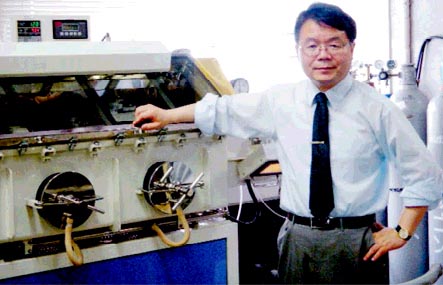Shinya Saeki, Nikkei Electronics
A Japanese research team developed a new yellow phosphor, "CL_MS phosphor," for white LEDs used in lighting apparatuses. The phosphor was co-developed by Koito Manufacturing, a research group led by Hideo Hosono (professor at the Tokyo Institute of Technology) and a group led by Hiroshi Sawa (professor at Nagoya University).
 |
| Hideo Hosono. |
A white LED using the new phosphor emits a soft light suited for indoor use and has a low cost, compared with existing white LEDs.
He did not disclose when Koito Manufacturing will start volume production of the phosphor but said that the company has already established a volume production technology for it and plans to have talks with LED and lighting apparatus makers.

A white LED using a newly developed yellow phosphor (left) and an existing white LED (right).
94% quantum efficiency
The CL_MS phosphor is made by adding Eu (europium)2+ as an activator for light emission to a mother crystal whose chemical formula is (Ca1-х, Srх)7 (SiO3)6,Cl2.
"It has a totally-new layered crystal structure," Koito Manufacturing said.
The CL_MS phosphor can convert purple light into yellow light with a quantum efficiency of 94%, absorbs a relatively small amount of blue light when being excited and realizes a high color reproducibility because it has a wide emission spectrum.
Koito Manufacturing developed a semispherical white LED whose diameter is 10mm by using the CL_MS phosphor, blue phosphor and purple LED chip. Compared with an existing white LED structure that measures 2 × 2mm to 3 × 3mm and is about 0.5mm thick, the density of phosphor particles was reduced by 90-95%, it said.
 |
| The CL_MS phosphor. |
5 advantages of new white LED
The newly-developed white LED has five major advantages. First, it has a high light flux and is bright. Compared with an existing product using the same purple LED chip and phosphor, its light flux is 25% higher. By applying phosphor particles with a low density, light is prevented from being blocked or scattered.
Second, the brightness of the new white LED is low in the front direction, reducing glare of white LED. Compared with an existing white LED made by combining a blue LED chip and a yellow phosphor (YAG), the light-emitting area and brightness of the new LED are 10 times larger and 1/10, respectively.
Third, the new LED has no directivity because its white light is made by two types of phosphors. And there is no variation in the white light despite its 10mm diameter spherical structure.
Fourth, because of the 10mm diameter spherical structure, the range of its light is wide. When the white LED is used in an LED lighting apparatus, it can brightly light up the entire room, Koito Manufacturing said.
Fifth, because a white LED using the CL_MS phosphor has no directivity, it can have a variety of shapes including not only semispherical shapes but also conical shapes.
 |
| Prototypes of LED Lighting devices. |
Cost advantage
Koito Manufacturing made the CL_MS phosphor with a self-flux method in which part of a crystal's raw material functions as a flux. The process temperature is about 800°C. Because it is an oxide-based phosphor, it does not require high-temperature (2,000°C), high-pressure (10 atm) or controlled atmosphere (oxygen-free condition) treatments. As a result, it is possible to reduce costs, the company said.